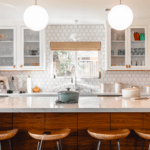
How to Buy a Backup Generator
December 26, 2013Christmas Cleanup Tips for the Not Naturally Organized
December 31, 2013The Workbench Life: Home
Comparing Countertop Materials
By Mindy Pantiel for The Workbench Life
Good looks play a major role in selecting kitchen countertop materials. But when you consider that the average counter endures hot pots, greasy foods, sharp knives and wine spills on a daily basis, durability and maintenance are essential factors, as well. To help you decide what countertop material is right for your kitchen, here’s a guide to some of the most popular options.
Laminate
Thanks to advances in printing technology, today’s laminates mimic stone, metal or wood with ease. Made with layers of paper and melamine resin, laminate kitchen countertop options are highly affordable and stain resistant, but can be damaged by sharp knives and hot pots. In general, the thicker the product, the more long-lasting it will be. Cost: $22–$52
Solid surfaces
Solid surfaces, such as Corian and Staron, also imitate the look of stone, but have the advantage of being colored throughout, so scratches can be sanded away. That said, solid surfaces do scratch easily, but the colors don’t fade with age and there are design options that resemble glass or concrete. Cost: $70–130
Granite
Often considered timeless and elegant, natural granite comes in literally thousands of colors. Heat and scratch resistant, it will repel stains when properly sealed, but is among the most expensive kitchen countertop options and is costly to transport. Cost: $95–225
Marble
“As long as it’s sealed and well-cared-for, marble is a beautiful surface — especially in a traditional kitchen,” says Certified Kitchen Designer Patti Weaver of Creative Design Solutions in Niwot, Colorado. Marble is a porous countertop material and requires regular maintenance and resealing for food safety. Available in white, black, gray, green and pink, it’s another classic material that never goes out of style. Cost: $127–$250
Engineered stone
Formed from quartz and a binder, engineered stones, such as Caesarstone and Silestone, have nonporous surfaces, making them more stain resistant than natural stone, but not necessarily less expensive. “While granite can definitely bring a unique pop of color to a room, I’ve been moving toward more environmentally friendly alternatives like Cambria,” says Weaver. “It’s a great granite look-alike, and it’s made in Minnesota.” Cost: $105–$187
Ceramic tile
Budget-friendly ceramic tile comes in a variety of colors, shapes, textures and sizes, making it easy to coordinate with different design styles. While resistant to heat, scratches, stains and moisture, the tiles can chip or crack, and the grout requires routine cleaning to prevent stains and mildew. Cost: $23–$124
Wood
Nothing warms up a kitchen like wood, and a practical butcher block is an ideal surface for chopping food without dulling your knives. Over time, the long-lasting countertop material also develops a beautiful patina. Properly sealed, wood countertops are sanitary for chopping meat, but they are vulnerable to moisture, heat, acid and stains, so routine maintenance is essential. Cost: $32–$200
Concrete
If you are looking for a good looking complement to other countertop materials like wood and stone, durable, heat-resistant concrete might be the answer. An extremely versatile material, concrete can be tinted and sculpted for maximum design possibilities. On the downside, it requires sealing and regular maintenance to combat stains and water. It’s also extremely heavy. Cost: $75–200
Green alternatives
A number of environmentally friendly options are available on the market. A blend of bamboo, recycled paper and wood fiber EcoTop offers good looks at a reasonable $35 a square foot. Another eco-conscious offering, Fuez, is a mix of glass, fly ash, stones and shells that is more durable than marble but needs to be sealed upon installation. Made from 60–80 percent recycled materials, it is manufactured in Portland using 100 percent wind energy. Cost: $80
Like this article? Get more by following us @WorkbenchLife or friending us on Facebook at The Workbench Life.
Mindy Pantiel frequently writes about home-related repair for design and architecture magazines.








